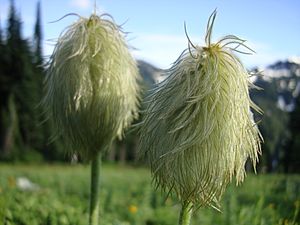White pasqueflower facts for kids
Quick facts for kids White pasqueflower |
|
|---|---|
 |
|
| The feathery seeds of the Western Pasqueflower | |
| Scientific classification | |
| Genus: |
Anemone
|
| Species: |
occidentalis
|
| Synonyms | |
|
Pulsatilla occidentalis (S. Watson) Freyn |
|
The Western Pasqueflower, also known as the white pasqueflower, is a beautiful plant found in the western parts of North America. Its scientific name is Anemone occidentalis. This plant is a type of herbaceous plant, which means it has soft stems instead of woody ones. It belongs to the Ranunculaceae family, which includes buttercups. Some scientists also place it in the genus Pulsatilla.
These plants can grow to be about 10 to 60 centimeters (4 to 24 inches) tall. They grow from a special underground stem called a caudex. At the base of the plant, there are usually three to six leaves. Each leaf is divided into smaller parts, like fingers on a hand. The stems that hold the leaves are about 6 to 10 centimeters (2.4 to 4 inches) long. The leaves are covered with soft, fuzzy hairs and have jagged or deeply cut edges.
Western Pasqueflowers bloom for a short time from mid-spring to mid-summer. They often appear soon after the snow melts, bringing a splash of color to the landscape. Each stem usually has one flower. The flowers have five to seven petals, which are actually called sepals. These sepals are usually white or a soft purple, sometimes even a mix of white and bluish-purple. Each sepal is about 15 to 30 millimeters (0.6 to 1.2 inches) long and 10 to 17 millimeters (0.4 to 0.7 inches) wide. Inside the flower, there are many stamens, which are the parts that produce pollen—sometimes as many as 150 to 200!
After the flower fades, it produces a unique fruit that looks like a fluffy, rounded or cylinder-shaped head. The stems holding these fruits can be quite long, about 15 to 20 centimeters (6 to 8 inches). The individual seeds, called achenes, are shaped like an oval and are covered with fuzzy hairs. They have long, feather-like "beaks" that can be 20 to 40 millimeters (0.8 to 1.6 inches) long. These beaks curve as they get older, helping the seeds to spread. The feathery fruits often stay on the plant well into the fall, making them easy to spot.
You can find the Western Pasqueflower in the far western parts of North America. This includes areas from British Columbia in Canada down to California in the United States, and also in states like Montana. It likes to grow in rocky soils on slopes and in damp meadows.
Plant Safety
The Western Pasqueflower contains natural chemicals that can be irritating. Because of this, it's important not to eat any part of the plant. If you see this plant in nature, it's best to enjoy its beauty without touching or tasting it.
Traditional Uses
In the past, some Indigenous groups in North America used the fresh stems and seeds of the Western Pasqueflower in their traditional medicine. They used it to help with pain, calm nerves, and as a mild sedative.
Interesting Places
There's a place called Pulsatilla Pass in Banff National Park in Canada. This pass was named after the Pulsatilla genus, which is another name for this type of flower.
Image gallery
-
Western Pasqueflower in Kootenay National Park, Canada
-
Western Pasqueflower on Mount Rainier with some seeds cut open to show the inside
See also
 In Spanish: Anemone occidentalis para niños
In Spanish: Anemone occidentalis para niños






